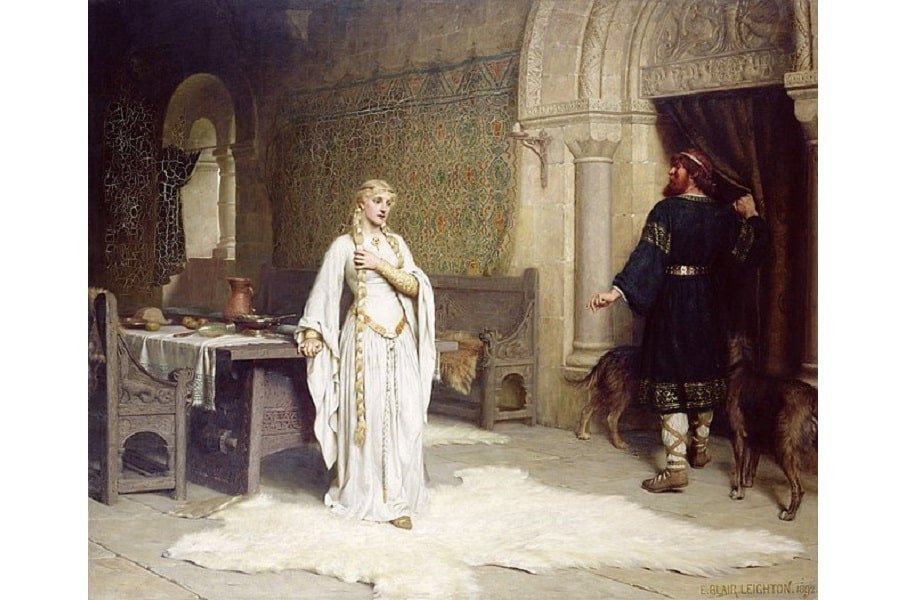Lady Godiva was an 11th-century Anglo-Saxon noblewoman who became famous for riding naked through the streets on the back of her horse. She did so in protest against her husband, trying to persuade him to reduce the taxes of the region they ruled.
However, historians are more and more debating the legitimacy of her story. Is the naked horse-riding lady really her? Or is there more to the story?
Table of Contents
Who Was Lady Godiva: The Life of Lady Godiva

Lady Godiva was the wife of someone who was named Leofric. With him, she had nine children. Leofric was known as the Earl of Mercia, a territory that stretched roughly between London and Manchester. Strictly following the story, Godiva was the one who married one of the highest-ranking noblemen that ruled over contemporary England.
The name Godiva comes from the word Godgifu or Godgyfu, which means ‘gift of God.’ Also, she and her husband were both part of some important religious houses, with both their families contributing large sums of money to different abbeys and monasteries in and around the city.
Although her influence was quite broad, her real fame came from a legendary occurrence in Coventry. It’s a story that was first recorded by the monks at St Albans Abbey over 800 years ago, in the 13th century. It’s evident that it’s a relevant story to this day, to the point that it is reenacted sporadically by the inhabitants of Coventry.
So why would the story of Lady Godiva be any different than that of any other noblewoman or man?
What is Lady Godiva Famous for?
Legend has it that Lady Godiva woke up one day and decided to ride horseback through the streets of Coventry. Mind you, she rode naked, in protest to the economic policy of her husband. The oppressive tax system that he implemented was deemed outrageous and made him unpopular with the inhabitants of Coventry and the wider Mercia region.
Although Lady Godiva tried to convince Leofric to refrain from implementing the taxes, he really couldn’t care less and intended to implement his plans on short notice. ‘You will have to ride naked through Coventry before I change my ways’, he would’ve said, assuming this would not happen by any stretch of the imagination.
Lady Godiva, however, had other plans. She knew that she was preferred over her husband by the citizens of Coventry. And besides, who wouldn’t root for a fairer tax system? With this knowledge in her possession, Lady Godiva approached the inhabitants of Coventry and asked them to stay indoors so that she could ride naked through the city.
And so the legend of the naked ride started. Off she rode, her long hair draping over her back, or actually almost her whole body. Legend has it that only her eyes and legs remained visible while she embarked on the nude ride to protest the crippling taxes of her husband.
After she rode naked through the city, she returned to her husband, who kept true to his word and reduced the taxes.

What Was Lady Godiva Protesting For?
While the story is that Lady Godiva was protesting against the heavy taxation, it might also have something to do with bringing peace to the violent nature of the noblemen in Mercia. This starts with her husband Leofric, who was unpopular because of the heavy taxation he implemented. In fact, his taxations were so contested that two of his tax collectors were killed.
While the Earl of Mercia wasn’t very happy with the unrest in the city, the king himself ordered the Earl to plunder and burn the city after he got word of the killings. In this environment, Lady Godiva was a figure that could calm down the tensions between all and everyone.
It’s a bit unsure in what year exactly the protest by Lady Godiva would’ve taken place. In fact, it’s unsure if it took place at all, as we will see in a bit. However, it’s certain that the taxes were heavy and the killings were real.
Was Lady Godiva Real?
We can be certain that Lady Godiva was a real person. However, it’s a bit far-fetched to say that historians are certain about the Lady Godiva story. In fact, there is almost a universal agreement that the story is not true.
For starters, there is uncertainty because the first written records only pop up hundred to two hundred years after the death of Lady Godiva. The man who wrote the story down first, Roger of Wendover, was also notorious for stretching the truth. This makes it even more unlikely that the story is exactly true.
The First Version of the Myth
The first version as written down by Mister Wendover included two knights on Lady Genova’s side while being cheered on by a large crowd. Sure, over the years it has evolved into something a bit more prudent, but it’s all derived from this first initial story.
Godiva and her husband were deeply religious, and the fact of the matter is that Christianity isn’t necessarily known for its expression of nudity. In fact, it’s quite the opposite. It’s not hard to see that a religious woman would rather avoid riding around town naked on a horse, being cheered on by a myriad of other men and women.

The Status of Lady Godiva
A death blow to the legitimacy of the story of Lady Godiva comes from other preserved texts that write about her role as a noblewoman.
One of the most legitimate sources is The Domesday Book of 1086, in which basically all the notable persons in England and their holdings were described. The book was written within a decade after the death of Lady Godiva. Therefore, it definitely seems to be a bit more reliable.
The book wrote about the possessions of Lady Godiva, which were quite remarkable for her time. She was one of the very few women that owned some land and controlled a number of estates in and around the city of Coventry.
Realistically, she simply owned much of the city and could do with it whatever pleased her. This, too, means that she herself could lower the taxes. If anything, Lady Godiva was the one that created the tax system of her city of Coventry, not her husband. The time period might’ve had something to do with how the myth turned out. More on that later.
Continuation of the Myth: Peeping Tom and the Coventry Fair
The fact that the naked ride of Lady Godiva isn’t true doesn’t mean that it’s not influential. Her story is nowadays an important part of the folklore of England, with implications of feminism and sexual liberation. However, just as with other legends, the story seems to be more so a reflection of every time period as opposed to it being a legitimate source of history.
While the story was written down initially in the 13th century, and the version we have today is radically different than that of 800 years ago. An important addition to the story comes in the form of a figure called ‘peeping Tom’, who first made its appearance in 1773.
Peeping Tom

According to the newer versions of the legend, one man wasn’t so loyal when asked to stay at home with closed doors and windows.
While Lady Godiva was strolling through the streets on her white stallion, a man that became known as ‘Tom the tailor’ couldn’t resist looking at the noble Lady. He was so determined to see her that he drilled a hole in his shutters and watched her ride by.
Little did Tom know that Lady Godiva was the Medusa of her time since he struck blind right after looking at Lady Godiva riding her horse. How he was blinded, however, isn’t really clear.
Some say he was struck blind by Lady Godiva’s beauty, others say he was beaten and blinded by the rest of the townspeople when they found out. Either way, the term peeping Tom derives from the modern installment of the story of Lady Godiva.
To add some more arguments in favor of the story not being based on a true occurrence, someone called ‘Tom’ or ‘Thomas’ was probably alien to the people of England during the time that the Lady of Coventry lived. The name is simply not Anglo-Saxon and only came into existence around the 15th or 16th century.
Coventry Fair
Outside the fact that part of the legend lives on in the English language through the term ‘peeping Tom’, the story of Lady Godiva is also celebrated with a Godiva procession. The first recorded procession that was dedicated to Lady Godiva took place in 1678, during an event called the Great Fair.
Since the late 17th century, the inhabitants of the British town have reenacted the ride of Lady Godiva as an annual event. Nowadays, it only happens sporadically and its occurrence seems to be decided by faith rather than tradition.
If people actually ride naked through the streets during the event, you ask? It depends. The conceptions surrounding nudity and expression certainly differ from time to time, influencing the form of the parade. Even in recent times, changes in expressions can be seen, for example between the hippie era in the1970s and the early 2000s.

Legendary and Influential to this Day
Other than the occasional procession, a Lady Godiva statue can be found in Coventry to this day. However, the single most iconic depiction of the story of Lady Godiva must be the Clock Tower in Coventry. The figures of Lady Godiva on her horse and Peeping Tom were carved out of wood and paraded around the clock every hour.
While the clock was a popular tourist attraction, the inhabitants of Coventry never really were big fans. This might’ve been the reason that the clock was broken in 1987 when the people of Coventry were celebrating the winning of the FA Cup by their local team. They climbed into the tower and damaged the clock in the process. Football fans, gotta love them.
Paintings and Murals
Lastly, as you might imagine, the scene of Lady Godiva riding the streets is an interesting subject for painters.
One of the most famous paintings was made by John Collier in 1897. Collier painted her in the original scene as described by the myth: riding through town naked on a horse. However, not all her depictions were like this.
Edmund Blair Leighton was the first one who painted her in a white dress. The color of the dress stands for purity, which reflects the desire of Lady Godiva to preserve her modesty. The change in depiction is often seen as an indication of a changing perception of women and their role in society.

Pop Culture References
The legend of Godiva continues to spread far beyond Coventry, for example through Godiva Chocolatier; a company founded in Brussels with more than 450 stores worldwide.
Still, maybe the most popular reference to the story can be found in Queen’s platinum song ‘Don’t Stop Me Now’, in which the legendary Freddie Mercury sings: ‘I’m a racing car, passing by like Lady Godiva’.
A Feminist Icon
As expected, Lady Godiva has become somewhat of a feminist icon over time. Actually, the very first version of her story might be formulated in a way that it was meant to be like that.
Remember Roger of Wendover, that lad who was the first to write her story down? Right, he was writing the story during a period when romance was spreading like wildfire through European politics. Courts became increasingly attended and even dominated by female figures, like Eleanor of Aquitaine and Marie of Champagne.
Godiva is believed to reflect more than a woman or a saint, or just a noblewoman. She was potentially even a medieval manifestation of a pagan goddess. In combination with the increasing presence of romance during that time, the Lady of Godiva can most certainly be seen as one of the first feminist symbols. Or, well, as far as we know.
The actual first wave of what we today deem to be ‘feminism’ only came in the 19th century. Not coincidentally, there was a renewed interest in Lady Godiva during this time, with attributing depictions and references.
What to Make of Lady Godiva
So, after all, what is there to say about Lady Godiva? While her story is interesting and has a spicy edge, the real story is the changes in society that it represents. It seems that Godiva can be used as a reflection of the times on topics surrounding nudity, sexuality, feminist freedom, and more.
It’s not a coincidence that she became depicted dressed in a white dress instead of fully naked; it tells a story about the woman and her role in society. The courage with which she is referred to in the story continues to inspire and will do so for the foreseeable future.